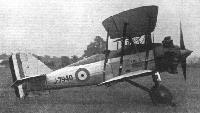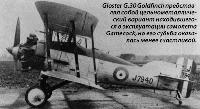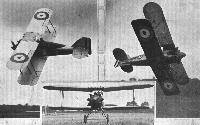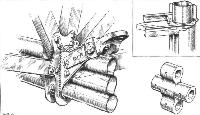Gloster Goldfinch
В начале 1926 года компания "Gloster" получила контракт от Министерства авиации на постройку цельнометаллического варианта самолета Gamecock. В итоге появился прототип J7940 самолета Gloster Goldfinch. Машина представляла собой одноместный биплан с неубирающимся шасси с хвостовым костылем, крыльями и хвостовым оперением цельнометаллической конструкции и фюзеляжем смешанной - деревянной и металлической - конструкции. Как и Gamecock, новый самолет оснащался звездообразным двигателем Bristol Jupiter, но другой модификации - Jupiter VIIF с турбонаддувом, поскольку самолет рассматривался в качестве высотного истребителя. После первого этапа испытаний фюзеляж машины удлинили, заменили смешанную конструкцию на цельнометаллическую, а также перепроектировали хвостовое оперение. В обновленном виде самолет поступил на официальные испытания в декабре 1927 года и показал весьма привлекательные характеристики, так что компания вполне резонно рассчитывала на серийный заказ. Однако надеждам не суждено было сбыться, после чего "Gloster" предложила самолет на тендер, проводившийся согласно спецификации F.9/26 на цельнометаллический дневной/ночной истребитель, но и здесь подряд получить не удалось - на этот раз самолет не удовлетворял предъявляемым согласно спецификации требованиям по запасу топлива и массе полезной нагрузки. Контракт на серийное производство от Министерства авиации получила фирма "Bristol" с ее Bristol Bulldog.
ТАКТИКО-ТЕХНИЧЕСКИЕ ХАРАКТЕРИСТИКИ
Gloster Goldfinch
Тип: одноместный высотный истребитель
Силовая установка: один девятицилиндровый звездообразный ПД Bristol Jupiter VIIF мощностью 450 л. с. (336 кВт)
Летные характеристики: максимальная скорость на высоте 3050 м - 277 км/ч; практический потолок 8215 м
Масса: пустого 933 кг; максимальная взлетная 1468 кг
Размеры: размах крыла 9,14 м; длина 6,78 м; высота 3,20 м; площадь крыльев 25,48 м2
Вооружение: два фиксированных стреляющих вперед 7,7-мм пулемета Vickers
Показать полностьюShow all
Flight, October 1928
THE GLOSTER "GOLDFINCH”
Bristol "Jupiter" Mark VII Engine
THE latest type of Gloster military aeroplane, of which particulars may be published, is the "Goldfinch," a single-seater fighter fitted with the Bristol "Jupiter" Mark VII engine. Put very briefly, it may be said that the "Goldfinch" is the all-metal version of the well-known Gloster "Gamecock," of which large numbers are in use by the British Royal Air Force. There are differences other than those of construction, but the "family likeness" is unmistakable. Fitted with the Bristol “Jupiter VII," which is a direct-drive supercharged engine specially designed to give maximum power at a considerable altitude, the "Goldfinch" develops its maximum horizontal speed (172 m.p.h. - 277 km. h.) at a height of about 10,000 ft. (3,050 m), but still maintains a very excellent speed at greater heights, so that even at 20,000 ft. (6,100 m.) the speed is as high as 157 m.p.h. (253 km./h.). The climb of the "Goldfinch" is equally excellent, as will be realised when we state that the altitude of 20,000 ft. is reached in 16 mins. 9 secs. If we add that the "service ceiling" (i.e., the altitude at which the rate of climb is 100 ft./min.) is 26,800 ft. (8,170 m.), it will be realised that the "Goldfinch" is a machine which, in point of performance, has few superiors.
Constructional Features
Of the aerodynamic design of the "Goldfinch" little need be said here. The machine differs hardly at all from the "Gamecock" in this respect, but the results of the Gloster company's experience in the design of racing aircraft are traceable in several details. The machine is of the normal single-bay biplane type, employing, as have done Gloster machines for a number of years, a high-lift aerofoil in the upper wing and a thin section aerofoil in the lower. It is, however, in the constructional design that the greatest interest of the "Goldfinch" lies, since all-metal construction is now demanded by the British Air Ministry, and this is the first machine incorporating this feature to be produced by the Gloster Aircraft Company.
Steel is the material chiefly used in the construction of the "Goldfinch," with Duralumin here and there to suit local requirements. The fuselage is a steel tube structure, in which use is made, in the front portion, of square-section tube for struts as well as longerons, no wire bracing being employed in this portion. The portion from aft of the pilot's cockpit to the stern post is built as a separate unit, bolted to the front one, and is of circular-section mild steel and Duralumin tubing, braced by tie rods. In the front portion, where the struts act both as tension and compression members, the joints between them and the longerons are flat mild steel plates bolted through struts and longerons, ferrules being inserted to prevent the fiat-sided tubes from buckling when the nuts are tightened up.
In the case of the rear portion, where the longerons and struts are of circular section and braced by tie rods, a different type of fitting has been used. This takes the form of a mild steel pressed plate fitting wrapped around the longeron and shaped to house the strut ends. Details are shown in some of our sketches.
Of particular interest as regards the front fuselage frame is the method of accommodating the steel spars of the lower centre-section or wing roots. The spars of the lower planes are of high tensile steel, of the section shown in one of our sketches. This type of spar starts life, so to speak, as a circular-section tube, and is then rolled to the "triple-barrel shot gun" section shown in the sketch. At the points where the spars are attached to the struts and longerons a Duralumin packing block is inserted, this block being machined to fit inside the spar section, as shown in the sketch.
The rectangular-section main structure of the fuselage is faired to a rounded section, the front fairing being of aluminium, while in the rear portion the formers are of wood.
Like the fuselage, the wings are of all-metal construction, with steel as the chief material. Reference has already been made to the form which the lower spars take. The top spars, also of high tensile steel, are of a different construction, with rolled top and bottom flanges of strip steel, diagonal bracing being used between top and bottom flanges. A false spar carries the narrow-chord ailerons.
The ribs, which are also of high tensile steel strip, are built up in the form of a Warren girder, with the top and bottom flanges and diagonal web members rolled to a trough section. There is, however, this difference that whereas in the flanges the edges are turned outwards, in the diagonal web members they are turned inwards. The web members are attached to the flanges by riveting.
The Bristol "Jupiter" Mark VII engine is mounted on a mild steel ring rigidly supported on struts which allow easy access to the engine, magnetos, etc. In the side elevation the arrangement of the engine mounting may be seen. In accordance with usual Gloster practice, the two petrol tanks are housed in the top 'planes, with direct gravity feed to the engine. The oil tank forms a cooler, and is let into the deck fairing behind the engine.
The tail plane, elevator, fin and rudder are also of steel construction, partly mild steel and partly high-tensile steel. The tail plane is arranged for trimming, being pivoted around its front spar, by means of a square-thread worm, sprocket wheel and cable.
The undercarriage, which is of wide track, is of the type in which the load is taken on rubber blocks working in compression, plates being interposed between adjacent blocks. Bouncing is prevented by an oil-damping device.
The pilot's seat is of the adjustable type, being raised and lowered by the movement of a lever. The weight of the pilot is taken by elastic shock absorbers, thus facilitating the raising of the seat while in flight.
Equipment
The "Goldfinch'' is provided with a very full equipment, including wireless, parachute, two machine guns, ammunition, oxygen apparatus, and electrical equipment, as well as all the usual navigation and engine instruments. Owing to its relatively low landing speed (under 60 m.p.h.) and wide wheel track, the "Goldfinch" might well be used as a night fighter. In that case, an exhaust ring is fitted. The installation of the two generators (wireless and lighting and heating) is unusual in that they are built into the top centre-section, thus giving a minimum of drag.
Flying Qualities
Pilots who have flown the machine report that the "Goldfinch" is very manoeuvrable and easy to control, and that the cockpit is well arranged, roomy, warm and comfortable, while the view is good for fighting, bombing and ground machine gunning. It is stated to have no vices, and to be very easy to land.
<...>
Performance
mins. secs.
Climb to 5,000 ft. (1,525 m.) 3 18
Climb to 10,000 ft. (3,050 m.) 6 30
Climb to 15,000 ft. (4,570 m.) 10 21
Climb to 20,000 ft. (6,100 m.) 16 9
Climb to 25,000 ft. (7,620 m.) 28 0
Absolute ceiling 28,000 ft. (8,539 m.)
Service ceiling 26.800 ft. (8,170 m.)
Speed at 10,000 ft. (3,050 m.) 172 m.p.h. (277 km/hr.)
Speed at 15,000 ft. (4,570 m.) 167 m.p.h. (269 km./hr.)
Speed at 20,000 ft. (6,100 m.) 157 m.p.h. (253 km./hr.).
Landing speed 59 m.p.h. (95 km./hr.).
Показать полностьюShow all









